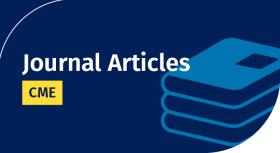
Airway Disease in Rheumatoid Arthritis
Rheumatoid arthritis (RA) is a common condition affecting approximately 1% of the general population. RA is a multisystem disorder that causes progressive articular destruction through synovial inflammation. One of the most common extraarticular manifestations of RA is pulmonary involvement, where all compartments of the pulmonary system can be impacted (e.g., pulmonary vasculature, pleura, parenchyma, and the airways).
Although it has been known for decades that a portion of patients with RA develop interstitial lung disease, and recent advancements in understanding the genetic risk and treatment for RA-interstitial lung disease have drawn attention, more recent data have begun to highlight the significance of airway disease in patients with RA. Yet, little is known about the underlying pathogenesis, clinical impact, or optimal treatment strategies for airway disease in RA. This review will focus on airway disease involvement in patients with RA by highlighting areas of clinical inquiry for pulmonologists and rheumatologists and discuss areas for future research.
Finally, we discuss a potential screening algorithm for providers when approaching patients with RA with respiratory complaints.
Target Audience
Pulmonologists, critical care specialists, translational researchers, and clinicians
Learning Objectives
At the conclusion of this activity, learners should be able to:
- Appropriately collaborate with rheumatologists when approaching airways disease in rheumatoid arthritis patients.
- Select the appropriate method for airway disease management when treating patients with rheumatoid arthritis (RA) inflammation and RA disease.
- Initiate earlier symptom-based screening, when appropriate, for airways disease in rheumatoid arthritis patients.
Accreditation Statement
The American Thoracic Society is accredited by the Accreditation Council for Continuing Medical Education to provide continuing medical education for physicians.
Disclosure Declaration
Article Authorship Disclosures (as submitted to the ATS prior to article publication date)
Scott M. Matson, M.D. (University of Kansas School of Medicine, Kansas City, KS) reported no relevant financial relationships.
M. Kristen Demoruelle, M.D., Ph.D. (University of Colorado at Denver, Aurora, CO) reported receiving grants from Pfizer.
Mario Castro, M.D., M.P.H. (University of Kansas School of Medicine, Kansas City, KS) reported receiving grants from NIH, ALA, PCORI, AstraZeneca, GSK, Novartis, Pulmatrix, Sanofi-Aventis, and Shionogi; receiving royalties from Elsevier; receiving consulting fees from Genentech, Teva, and Sanofi-Aventis, Novartis; and receiving payment for speaking or lectures from AstraZeneca (Unbranded disease state only), Genentech, GSK, Regeneron, Sanofi, and Teva..
Off-Label Usage Disclosure
None
Disclosures of AnnalsATS CME Planners
The Annals of the American Thoracic Society (AnnalsATS) original research, commentaries, reviews, and educational content of interest to clinicians and clinical investigators in pediatric and adult pulmonary and sleep medicine and medical critical care. The scope of the journal encompasses content that is applicable to clinical practice, the formative and continuing education of clinical specialists, and the advancement of public health.
The publication of articles that meet these goals by itself is only one step in a multi-step process for the translation of evidence-based improvements in are to clinical practice. Testing for CME credit is designed to function as a next step in the process. This is accomplished through a series of questions written by the author(s) to test that readers have the tools needed to translate recommendations for diagnostic and therapeutic clinical care into clinical practice. Members of the AnnalsATS editorial board review these questions and edit these questions for clarity, educational content, and the quality of the evidence.
AnnalsATS CME Planners
Alan M. Fein, M.D.
Podcast Editor, AnnalsATS
Dr. Fein reported that he has no financial relationships with ineligible companies.
Constantine Manthous, M.D.
Associate Editor, AnnalsATS
Dr. Manthous reported that he has no financial relationships with ineligible companies.
Gregory A. Schmidt, M.D.
Editorial Board, AnnalsATS
Dr. Schmidt reported payments for writing a textbook on critical care medicine (McGraw-Hill) and for writing contributions for UptoDate.
Instructions to Receive Credit
To receive credit for this journal article:
- Read the journal article. Keep track of how long it takes you to read it.
- Once you open the article, the Post-Test becomes available. After reading the article, answer the post-test questions. You must answer all questions correctly to earn credit. You may take the test as many times as you like.
- Once you pass the Post-Test, the Evaluation becomes available. Answer all the evaluation questions.
- Once you complete the evaluation, select the amount of credit to receive based on the time it took you to read the article.
- You can view, save and print your Certificate by pressing the Certificate button.
- To review the credits you've earned in this system and reprint certificates, go to the My Learning drop-down list. Then select Transcript.
Available Credit
- 1.00 AMA PRA Category 1 Credit(s)™The American Thoracic Society designates this for a maximum of 1.00 AMA PRA Category 1 Credit(s)™. Physicians should claim only the credit commensurate with the extent of their participation in the activity.
- 1.00 Participation

 Facebook
Facebook X
X LinkedIn
LinkedIn Forward
Forward